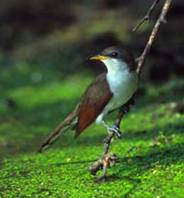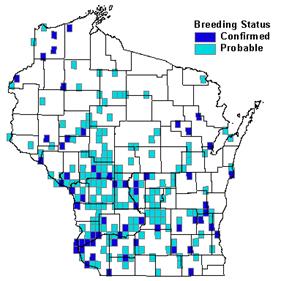Photo by James Gallagher


Status/Protection
- Global Rank: G5 Key to global and state ranks
- State Rank: S3B
- WBCI Priority: SGCN, Special Concern
Population Information
Federal BBS information can be obtained at http://www.mbr-pwrc.usgs.gov/bbs/bbs.html by clicking on Trend Estimates and selecting the species in question. All estimates are for 1966-2005.
- Federal Breeding Bird Survey: significant decline
- Federal Breeding Bird Survey (WI): significant decline
- Federal Breeding Bird Survey (BCR 23): non-significant decline
- Federal Breeding Bird Survey (BCR 12): non-significant decline
- WSO Checklist Project: declining (1983-2007)
Life History
- Breeding Range: Primarily states east of the Rockies; isolated populations in the western U.S. (Hughes 1999).
- Breeding Habitat: Shrub-Carr, Bottomland Hardwood, Oak, open deciduous woodlands with dense shrubby undergrowth.
- Nest: Platform, usually <10 m above ground (Ehrlich et al. 1988, Hughes 1999).
- Nesting Dates: Eggs: late May to early August (WSO 1995).
- Foraging: Foliage glean, hover and glean, hawks (Ehrlich et al. 1988).
- Migrant Status: Neotropical migrant.
- Habitat use during Migration: Second-growth woodlands, hedgerows, edge of forests, gardens, scrub (Hughes 1999).
- Arrival Dates: Early May to early June (Robbins 1991).
- Departure Dates: Mid-August to late September (Robbins 1991).
- Winter Range: Most of northern South America, Andes Mts., eastern Brazil (DeGraaf and Rappole 1995).
- Winter Habitat: All types of woody vegetation, often near water, scrub, mangroves, riparian vegetation, open woodlands, forest edge (Hughes 1999).
Habitat Selection
The Yellow-billed Cuckoo inhabits upland oak forests or woodlands, wooded bottomlands, Grassland-shrub-carr, shrubs at woodland edges, hawthorns, and dense willow or dogwood thickets (Hughes 1999, Robbins 1991). In some areas of Wisconsin, e.g., the Baraboo Hills, Yellow-billed Cuckoos are found more often in the forest canopy than in shrubs (Mossman and Lange 1982). Elsewhere in Wisconsin it has been found in pine-oak barrens (Mossman and Epstein 1991), northern swamps and bogs (Hoffman and Mossman 1993), northern mesic forests (Hoffman 1989), southern dry forest (Mossman and Hoffman 1989), and even on the Apostle Islands (Temple and Harris 1985). Nests are often near streams or edges of lakes. Most nests are within 1-6 meters of the ground, and on a horizontal branch or fork, usually 2-4 meters from the trunk of an oak, elm, dogwood, hawthorn, or ash (Hughes 1999).
In the eastern U.S., Gale et al. (1999) found that both Yellow-billed and Black-billed Cuckoos appeared on BBS routes (where they had not been previously detected) two years prior to an outbreak of gypsy moth, and then disappeared immediately after the outbreak. Although the sample size of this study was small, it does suggest that food resources can affect habitat selection of the Yellow-billed Cuckoo. Similarly, Yellow-billed Cuckoo sightings tripled in a single year following a tent caterpillar outbreak in Wisconsin (Anderson 2006).
Habitat Availability
Although this species has the most widespread distribution of the cuckoos in North America, it is less widespread in Wisconsin than the Black-billed Cuckoo. The Wisconsin Breeding Bird Atlas indicates that higher densities of Yellow-billed Cuckoo are found south of the tension zone. Yellow-billed Cuckoo is sensitive to habitat loss and fragmentation, but because this species is found in so many habitat types throughout the state, it is not clear if habitat availability is a limiting factor.
Population Concerns
The Yellow-billed Cuckoo has declined quite dramatically across its North American range, warranting endangered species designations in some western states. Breeding Bird Survey data suggest significant annual declines both range-wide and in Wisconsin (Sauer et al. 2005). Breeding activity in Wisconsin is concentrated primarily in the southern half of the state. During the six-year period (1995-2000) of the Wisconsin Breeding Bird Atlas, observers recorded evidence of breeding in 31% of the surveyed quads (Anderson 2006).
Populations may be highly variable locally depending on food availability (Hughes 1999). In Michigan caterpillar irruptions resulted in large influxes of cuckoos to that area (Eastman 1991). Indiscriminate spraying to combat gypsy moth larva could adversely affect other caterpillar concentrations, thus reducing available prey for Yellow-billed Cuckoos. Yellow-billed Cuckoos also may suffer from pesticide poisoning by ingesting caterpillars from treated areas (Hughes 1999).
Recommended Management
Management efforts for this species should focus on maintaining large blocks of floodplain forests south of the tension zone. Conserve large blocks of forest that are subject to natural processes and various levels of disturbance. Spraying programs intended for tent caterpillars should be curtailed or reduced in Yellow-billed Cuckoo habitat (Hughes 1999). Conservation and management strategies for this species should be focused in the following ecological landscapes: Central Sand Hills, Southeast Glacial Plains, and Western Coulee and Ridges (WDNR 2005).
Research Needs
More research is needed into the causative factors of this species’ long-term population decline. Many aspects of Yellow-billed Cuckoo ecology are not sufficiently described, including reproductive success, territorial spacing, and site tenacity. Interspecific brood parasitism in this species also needs further exploration. In addition, habitat and ecological requirements on migratory routes and wintering grounds in Central and South America should be investigated. (Hughes 1999).
Information Sources
- Chequamegon NF bird survey map:http://oden.nrri.umn.edu/mnbirds/accounts/YBCUm2.htm
- Chequamegon National Forest Bird Survey (NRRI) species account: http://oden.nrri.umn.edu/mnbirds/accounts/YBCUa2.htm
- Nicolet NF bird survey map: http://www.uwgb.edu/birds/nnf/species/YBCU.htm
- North American Breeding Bird Survey: http://www.npwrc.usgs.gov
- Temple S.A., J.R. Cary, and R. Rolley. 1997. Wisconsin Birds: A Seasonal and Geographical Guide. Wisconsin Society of Ornithology and Wisconsin Department of Natural Resources, Madison, WI.
- Wisconsin Breeding Bird Atlas: http://www.uwgb.edu/birds/wbba/
References
- Anderson, J. 2006. Yellow-billed Cuckoo. In Atlas of the Breeding Birds of Wisconsin. (N.J. Cutright, B.R. Harriman, and R.W. Howe, eds.) The Wisconsin Society for Ornithology, Inc. 602pp.
- DeGraaf, R.M., and J.H. Rappole. 1995. Neotropical migratory birds: natural history, distribution, and population change. Comstock Publ. Assoc., Cornell Univ. Press, Ithaca, NY.
- Ehrlich, P.R., D.S. Dobkin, and D. Wheye. 1988. The birders handbook: a field guide to the natural history of North American birds. Simon & Schuster, Inc. New York.
- Gale, G.A., J.A. DeCecco, M.R. Marshall, W.R. McClain, and R.J. Cooper. 1999. Effects of gypsy moth defoliation on forest birds: an assessment using breeding bird census data. J. Field Ornithology 72(2): 291-304.
- Hoffman. R.M. 1989. Birds of Wisconsin northern mesic forests. Pass. Pigeon 51(1): 97-110.
- Hoffman, R.M., and M.J. Mossman. 1993. Birds of Wisconsin’s northern swamps and bogs. Pass. Pigeon 55(2): 113-137.
- Hughes, J.M. 1999. Yellow-billed Cuckoo (Coccyzus americanus). In The Birds of North America, No. 418 (A. Poole and F. Gill, eds.). The Birds of North America, Inc., Philadelphia, PA.
- Mossman, M.J. and K.I. Lange. 1982. Birds of the Baraboo Hills: Their History, Distribution, and Ecology. Wisconsin Dept. of Natural Resources, and Wisconsin Society for Ornithology, Madison, WI.
- Mossman, M.J. and R.M. Hoffman. 1989. Birds of southern Wisconsin upland forests. Pass. Pigeon 51(4): 343-358.
- Mossman. M.J. and E. Epstein. 1991. Birds of Wisconsin pine and oak barrens. Pass. Pigeon 53(2): 137-163.
- Robbins, S.D. 1991. Wisconsin birdlife: population & distribution, past & present. Univ. of Wisconsin Press, Madison, WI.
- Sauer, J.R., J.E. Hines, and J. Fallon. 2005. The North American Breeding Bird Survey, Results and Analysis 1966 - 2005. Version 6.2.2006. USGS Patuxent Wildlife ResearchCenter, Laurel, MD.
- Temple, S.A., and J.T. Harris. 1985. Birds of the Apostle Islands. Wisconsin Society for Ornithology, Hartland, WI.
- Wisconsin Department of Natural Resources (WDNR). 2005. Wisconsin’s Strategy for Wildlife Species of Greatest Conservation Need. Madison, WI.
- Wisconsin Society for Ornithology (WSO). 1995. Wisconsin breeding bird atlas; atlasing handbook 1995-1999. Wisconsin Society for Ornithology, Inc., Hartland, WI.
Contact Information
- Compiler: William P. Mueller, iltlawas@earthlink.net
- Editor: Rick Anderson, Rick.Anderson@co.clark.wi.us | Kim Kreitinger, K.Kreitinger@gmail.com
